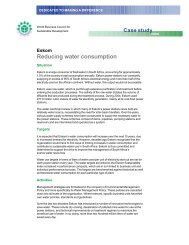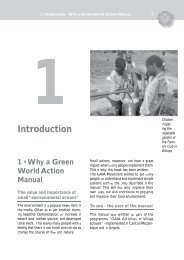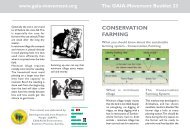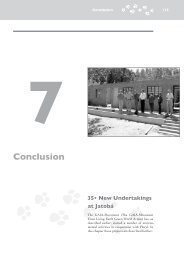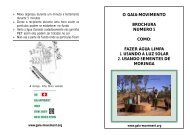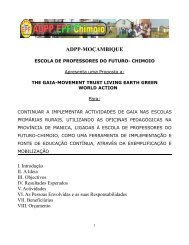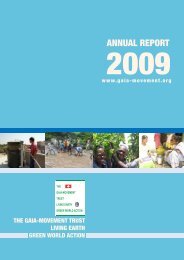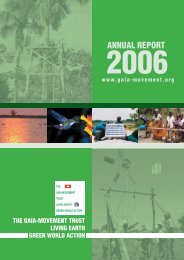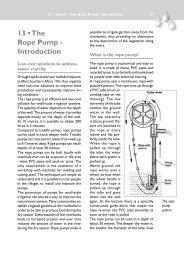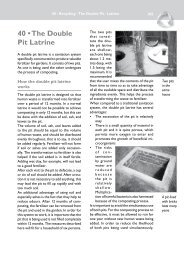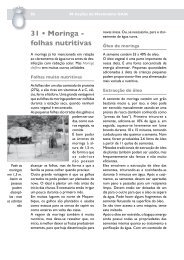Open or download the presentation as a PDF file - The Gaia ...
Open or download the presentation as a PDF file - The Gaia ...
Open or download the presentation as a PDF file - The Gaia ...
You also want an ePaper? Increase the reach of your titles
YUMPU automatically turns print PDFs into web optimized ePapers that Google loves.
Carbon Reducing Activities<br />
at HPP Projects<br />
Tree planting<br />
Firewood saving stoves<br />
Planting rows of vetiver gr<strong>as</strong>s<br />
Conservation farming systems<br />
Reducing def<strong>or</strong>estation and fires<br />
Using jatropha <strong>as</strong> biofuel
Def<strong>or</strong>estation<br />
accounts f<strong>or</strong> 20%<br />
of global warming.<br />
It is <strong>the</strong>ref<strong>or</strong>e<br />
necessary to show<br />
farmers alternatives<br />
to sl<strong>as</strong>h and<br />
burn farming.<br />
And promote tree<br />
from which <strong>the</strong>y<br />
can generate<br />
income.
Planting trees f<strong>or</strong> firewood in Africa<br />
1 tree st<strong>or</strong>es over 15 years: 1.8 tons CO 2<br />
1 tree in Africa per year: 0.1 tons CO 2<br />
50 trees can supply a family with firewood
Thousands of<br />
farmers in Zambia<br />
have been<br />
mobilised to plant<br />
and let new Msangu<br />
trees grow up in<br />
<strong>the</strong>ir fields.<br />
<strong>The</strong>y enrich <strong>the</strong><br />
soils, and yields are<br />
better under <strong>the</strong><br />
trees.
Zambians at DAPP<br />
projects have built<br />
thousands of <strong>the</strong>se<br />
stoves that save<br />
m<strong>or</strong>e than 1/3 of <strong>the</strong><br />
firewood.<br />
1 stove saves over 1<br />
ton firewood/year<br />
1 stove reduces<br />
emissions with about<br />
2 tons CO 2 /year
This Rocket Stove in Children’s Town,<br />
Zambia, saves over 50% firewood
Contours of vetiver gr<strong>as</strong>s reduce loss of<br />
nutrients and m<strong>or</strong>e water penetrates into<br />
<strong>the</strong> soil. But <strong>the</strong>y also st<strong>or</strong>e carbon since<br />
<strong>the</strong>y continue to grow f<strong>or</strong> up to 50 years.
Root system of 2-<br />
year old vetiver<br />
gr<strong>as</strong>s in China.<br />
It is estimated that<br />
1 km of vetiver row<br />
(8,000 plants)<br />
st<strong>or</strong>es 2 tons<br />
CO 2 /year m<strong>or</strong>e than<br />
what would occur<br />
o<strong>the</strong>rwise.
Conservation Farming, here in Zimbabwe,<br />
not only preserves nutrients and water.<br />
1 hectare annually st<strong>or</strong>es ¼ to ½ t CO 2 .
Avoid bushfires. Farmers Clubs and o<strong>the</strong>r<br />
HPP projects mobilise people only to use<br />
controlled fires. 3-4 T CO 2 will <strong>the</strong>n be<br />
st<strong>or</strong>ed annually in trees, roots and soils.
Farmers are also sensitised to use permanent<br />
fields instead of sl<strong>as</strong>h and burn farming.<br />
This reduces labour, preserves biodiversity and<br />
reduces emissions of CO2. Preventing burning<br />
of f<strong>or</strong>ested land saves 100-200 T CO 2/ha
Community preserved are<strong>as</strong>, here in<br />
Zambia, similarly st<strong>or</strong>e 3-4 T CO 2 /ha<br />
annually by preventing fires and felling.
Many HPP projects promote jatropha trees<br />
f<strong>or</strong> local biofuel production from <strong>the</strong> seeds.<br />
<strong>The</strong> oil is used in stationary engines and -<br />
when production incre<strong>as</strong>es - f<strong>or</strong> biodiesel.
<strong>The</strong> biofuel project<br />
in Chibombo<br />
District, Zambia,<br />
h<strong>as</strong> planted 83,000<br />
jatropha trees.<br />
HPPI have planted<br />
over 200,000.<br />
40,000 jatroph<strong>as</strong> in<br />
Bilibiza, Moz. and<br />
<strong>the</strong>y will plant<br />
300,000 this year.
Pressing oil from jatropha seeds<br />
Jatropha seeds are pressed manually <strong>or</strong><br />
mechanically.<br />
4 kg of seeds are needed to produce 1 l oil.
<strong>The</strong> dual fuel system<br />
Plant oil does not run so e<strong>as</strong>ily <strong>as</strong> diesel. It is<br />
<strong>the</strong>ref<strong>or</strong>e necessary to heat up <strong>the</strong> engine first<br />
by running on diesel f<strong>or</strong> at le<strong>as</strong>t 10 minutes.<br />
To avoid deposits in filters and inject<strong>or</strong>s, <strong>the</strong><br />
engine must run on diesel f<strong>or</strong> 10 minutes bef<strong>or</strong>e<br />
stopping it.
Testing <strong>the</strong> use of plant oil in <strong>the</strong> first<br />
version of <strong>the</strong> dual fuel system<br />
Two grinding mills have run a total of 107<br />
hours on cottonseed oil without problems.
Running a Zambian grinding mill on plant<br />
oil. 10 mills have <strong>the</strong> extra tank and<br />
switch, and will use locally made oil.
Delhi College of<br />
Engineering conducts<br />
512 hours endurance<br />
test of jatropha in<br />
dual fuel system at<br />
varying loads.<br />
Engine starts and<br />
stops with diesel to<br />
clean out filters and<br />
inject<strong>or</strong>s.
Testing <strong>the</strong> use of plant oil in <strong>the</strong> second<br />
version of <strong>the</strong> dual fuel system<br />
<strong>The</strong> oil is heated by <strong>the</strong> exhaust to make it<br />
m<strong>or</strong>e like diesel in viscosity.
HPPI farmers checking an engine running<br />
on jatropha oil. At 2 l fuel/hour, this saves<br />
5 kg CO 2 per hour. About 5 tons CO 2 /year.
Jatropha oil can also<br />
be used <strong>as</strong> lamp oil.<br />
This oil is – unlike<br />
<strong>the</strong> candles and<br />
kerosene it replaces<br />
– carbon neutral.<br />
Carbon w<strong>as</strong> st<strong>or</strong>ed in<br />
<strong>the</strong> jatropha seeds<br />
during <strong>the</strong> growth.<br />
And is again rele<strong>as</strong>ed<br />
to <strong>the</strong> atmosphere<br />
when it is burned.
ADPP Moz. is imp<strong>or</strong>ting solar t<strong>or</strong>ches.<br />
F<strong>or</strong> many, <strong>the</strong> USD 15, is less than ½<br />
years expense f<strong>or</strong> candles and kerosene.
ADPP Moz. h<strong>as</strong> now<br />
installed 3 wind rope<br />
pumps – here in<br />
Chimoio.<br />
At about USD 800<br />
<strong>the</strong>y are still too<br />
expensive f<strong>or</strong> most<br />
small farmers.<br />
But <strong>the</strong>y can be used,<br />
where farmers can<br />
get good prices f<strong>or</strong><br />
<strong>the</strong>ir products.



